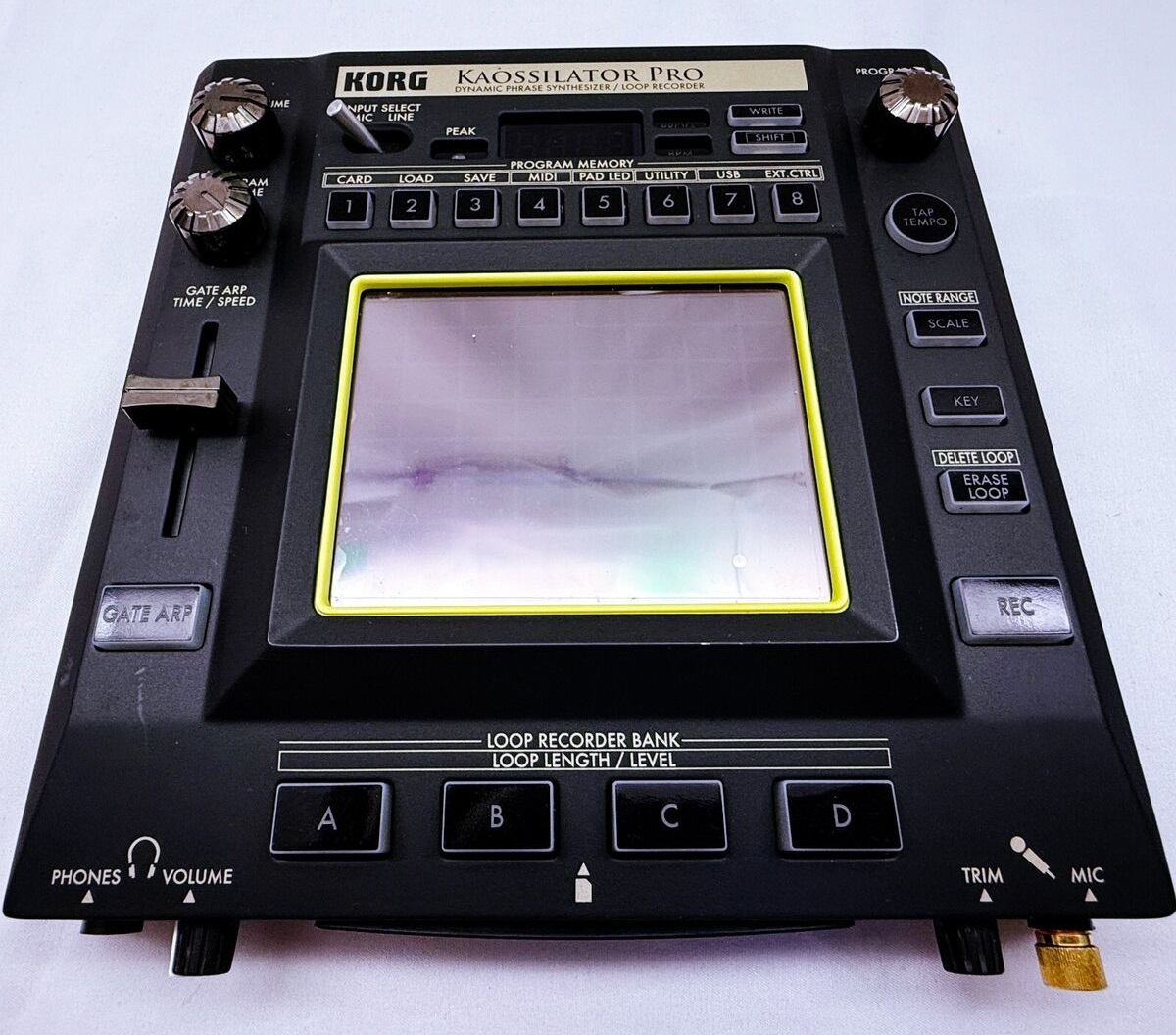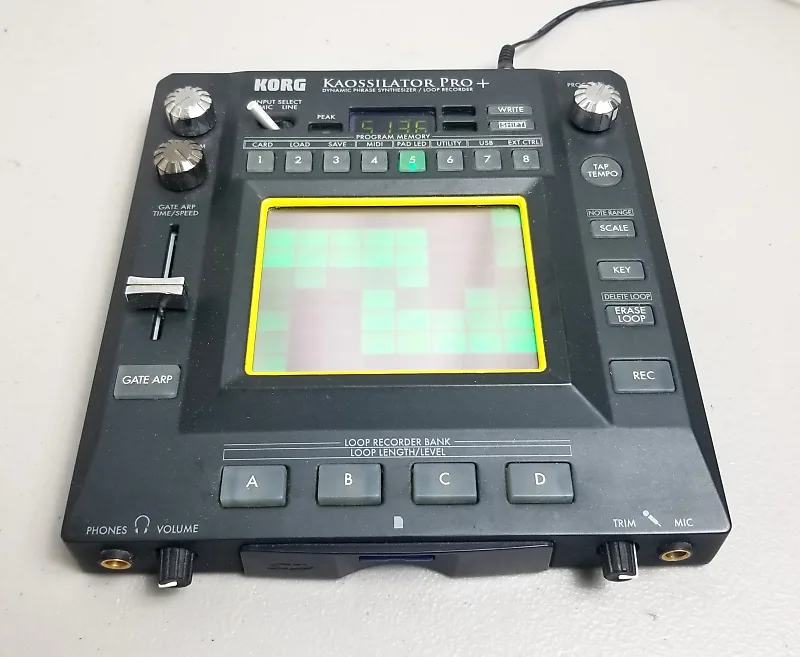Kaossilator
Electronic Instruments
Asia
Between 1901 and present
Video
The Kaossilator is a unique digital musical instrument developed by Korg, a well-known Japanese company specializing in electronic musical instruments and synthesizers. The Kaossilator is classified as a dynamic phrase synthesizer, a type of synthesizer that allows users to create loops, melodies, and rhythms by interacting with a touch-sensitive X-Y pad. Unlike traditional keyboards or synthesizers, the Kaossilator does not use physical keys; instead, it employs a touchpad that enables musicians to play notes and manipulate sounds in real time through finger movements.
The instrument is compact and designed for portability, making it ideal for both professional musicians and hobbyists. It features a wide range of built-in sounds, effects, and rhythm patterns, covering various genres such as electronic, hip-hop, dance, and experimental music. The Kaossilator’s sound engine includes synthesized tones, drum kits, bass lines, and melodic instruments, providing versatility in music production.
Due to its innovative design and user-friendly interface, the Kaossilator is often used for live performances, studio recordings, and DJ setups. It is particularly favored by electronic music producers because of its ability to create loops and sequences effortlessly. With each new iteration, Korg has introduced improvements in sound quality, effects, and real-time recording capabilities, making the Kaossilator a staple in modern electronic music production.
History and Origin
The Kaossilator originates from Japan and was first introduced in 2007 by Korg, a pioneering company in electronic music instruments. Korg has been a major player in the synthesizer industry since the 1960s, producing iconic instruments that have influenced multiple genres of music. The development of the Kaossilator was a response to the growing demand for intuitive, touch-based electronic instruments that could be used both by professional musicians and casual users.
The 21st century witnessed a rise in portable electronic instruments, fueled by advancements in digital signal processing (DSP) and touch-sensitive technology. The Kaossilator was inspired by Korg’s earlier Kaoss Pad, a popular effects processor that utilized an X-Y touchpad to manipulate sound parameters. The success of the Kaoss Pad led Korg to explore the idea of an instrument that could generate melodies and rhythms using the same touchpad interface, giving birth to the first-generation Kaossilator. Since its debut, the Kaossilator has undergone multiple upgrades, with new versions like the Kaossilator Pro (2010) and the Kaossilator 2 (2012) offering expanded features, improved looping functions, and greater control over sound design. The Kaossilator Pro+ further enhanced the capabilities by adding more presets and expanding the loop recording options.
While the Kaossilator’s concept was revolutionary, it also drew inspiration from earlier synthesizers and sequencers. The idea of touch-based sound manipulation has existed since the mid-20th century, but Korg’s execution of the concept in a portable, user-friendly format made the Kaossilator stand out.
Types and Features
The Kaossilator series includes different models, each offering unique features suited for various types of musicians and producers. The primary types of Kaossilators are:
Original Kaossilator (2007)
- Compact, battery-powered synthesizer with a touchpad interface
- Includes 100 preset sounds covering bass, leads, drums, and sound effects
- Looper function for layering multiple sound layers
- Simple interface, making it accessible to beginners
Kaossilator Pro (2010)
- Larger and more advanced version with improved looping capabilities
- Features a four-track loop recorder, allowing users to build complex layers
- MIDI connectivity for integration with other hardware and software
- Expanded preset library with 200+ sounds
Kaossilator 2 (2012)
- Smaller, pocket-sized version with a color touch screen
- Includes built-in microphone for sampling external sounds
- Improved user interface for easier sound selection and looping
- Enhanced looping with the ability to save and recall loops
Kaossilator Pro+ (2013)
- Further expansion of the Pro model with additional presets
- Higher-quality sound engine with more dynamic effects
- Ideal for live performances and professional music production
Each version of the Kaossilator maintains the core touchpad-based playability, ensuring that musicians can create music with simple gestures. The instrument does not require prior knowledge of music theory, as the scale and key settings help keep notes in tune, making it easy for beginners to generate melodies effortlessly.
Work Mechanics and Playing Technique
The Kaossilator functions using an X-Y touchpad, where the horizontal axis (X-axis) controls pitch and the vertical axis (Y-axis) adjusts various sound parameters such as volume, modulation, or effects. This touch-based interaction allows for expressive and dynamic performance techniques.
Playing Methods
Finger Gliding: Moving a finger across the touchpad produces smooth, continuous notes, similar to a theremin.
Tapping: Quick taps trigger individual notes, creating percussive effects.
Holding and Modulating: Holding a finger in place sustains a note, while vertical movements modulate its tone.
The Kaossilator also includes loop recording and overdubbing, allowing users to build multi-layered compositions in real-time. With features like scale selection, users can set the instrument to a specific musical scale (major, minor, pentatonic, blues, etc.), ensuring that all notes played are harmonically correct.
MIDI connectivity in the Pro versions allows integration with DAWs (Digital Audio Workstations), MIDI controllers, and synthesizers, expanding the creative possibilities for studio production. The sync function enables users to align rhythms with external drum machines or sequencers, making it an excellent tool for live performances.
Role in Music
The Kaossilator has significantly influenced various music genres, particularly electronic, hip-hop, experimental, ambient, and dance music. Its unique interface and looping capabilities make it a powerful tool for live improvisation, beat-making, and sound experimentation.
Use in Live Performances: DJs and electronic artists use the Kaossilator to create spontaneous loops and textures. It serves as a portable lead synth for soloing over pre-recorded tracks. Musicians integrate it into performances alongside drum machines and samplers.
Use in Studio Production: The Kaossilator’s diverse sound library helps producers generate melodic and rhythmic ideas quickly. Its MIDI functionality allows it to be used as a controller for triggering sounds in software synthesizers. Artists use it for creating atmospheric pads, arpeggios, and sound effects.
The instrument is also used in educational settings, where it helps beginners understand musical scales, rhythm patterns, and improvisation techniques in a hands-on, interactive manner.
Significance of the Kaossilator
The Kaossilator’s significance lies in its accessibility, portability, and innovative design, which have made it a favorite among musicians of all levels. Unlike traditional instruments that require technical skills, the Kaossilator allows users to create music without any prior knowledge of music theory. Its intuitive interface makes it possible for anyone to experiment with melodies, rhythms, and harmonies effortlessly.
The Kaossilator has become a staple for electronic musicians, particularly in live performance settings. Its ability to generate loops in real time has influenced how DJs and producers structure their performances, enabling on-the-fly improvisation. Korg’s Kaossilator has inspired other music hardware and software developers to explore touch-based sound manipulation. Many modern digital instruments and apps have incorporated similar X-Y pad interfaces for sound modulation and sequencing. The Kaossilator’s loop recording function has made it a valuable tool for songwriting and beat-making, allowing musicians to create full compositions using a single device. Its wide range of preset sounds ensures that it can be used in multiple genres, from hip-hop to ambient music. Being battery-powered and lightweight, the Kaossilator is an excellent choice for musicians who need a compact, all-in-one solution for music creation on the go. Whether used in a live performance, studio session, or casual jam, it offers a versatile and enjoyable experience.
The Kaossilator is a groundbreaking instrument that has redefined how music can be played and produced. With its touch-based interface, looping capabilities, and diverse sound library, it has found a place in both professional and amateur music-making. As technology advances, the Kaossilator continues to evolve, remaining an influential tool in the world of electronic music and live performance. Its impact on modern music production, accessibility, and creativity ensures its legacy as one of Korg’s most innovative instruments.
FAQ
What is the primary method of sound production in the Kaossilator?
The primary method of sound production in the Kaossilator is through the use of an X/Y touchpad. Users generate sounds by moving their fingers across the pad, with horizontal movements typically changing pitch and vertical movements modulating other sound parameters. This method allows for expressive and dynamic sound creation.
How does the Kaossilator's looping feature work?
The Kaossilator's looping feature allows users to record and layer sounds to create complex musical patterns. The original model can record loops up to two bars in length, but later models like the Kaossilator 2 offer more extensive looping capabilities, including dual loop recording and unlimited overdubs.
What types of sounds can the Kaossilator produce?
The Kaossilator can produce a wide range of sounds, including synthesizer voices, acoustic instruments like guitar and trumpet, percussion, and electronic effects. Models like the Kaossilator 2 also feature realistic drum sounds thanks to the PCM sound engine.
 Links
Links
References
 Similar
Similar
Instruments
Other Instrument
Categories



















